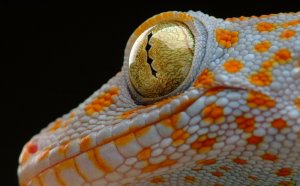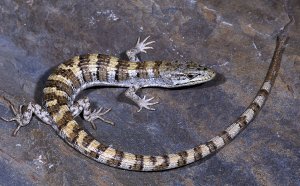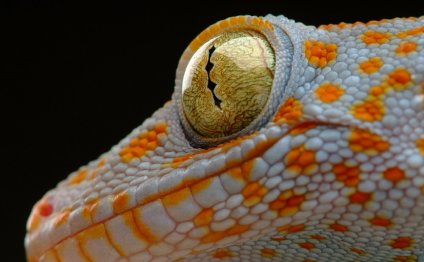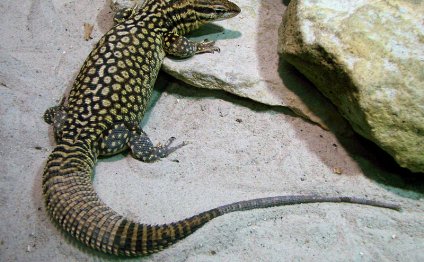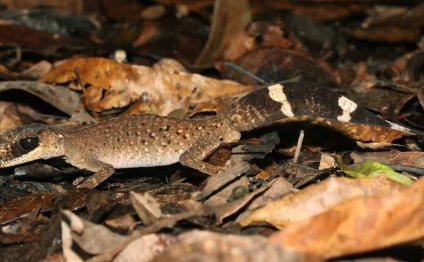
Breeds of geckos
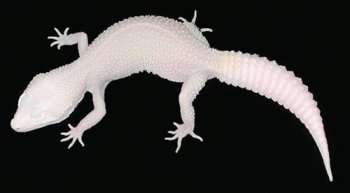
Leopard Habitat
A 10- to 20-gallon aquarium houses two leopard geckos for their entire lives from hatchling to adult. Caging should be at least 1 foot tall, and have a secure screen top that will support a light fixture and keep bothersome cats from dining on your pet. Live or artificial plants can be added for decoration.
Newspaper, pea gravel, artificial turf, flat stones or no floor covering are good substrate choices for leopard geckos. Sand or fine-particle products on the cage floor can cause intestinal impaction if consumed by young or debilitated geckos.
Ron Tremper
All leopard geckos, including this diablo blanco morph, are active at night and do not need to bask under UVB lighting.
A hide box measuring 6 to 7 inches in diameter filled with moist peat moss or vermiculite is required, so your leopard can shed its skin and lay eggs properly.
The ideal temperature in the hide box is 86 to 90 degrees Fahrenheit at all times. This is a leopard gecko’s hotspot. The ambient air temperature should be at least 73 degrees. An undertank heating pad or heat tape is the best way to provide the proper hotspot temperature. Avoid heat rocks because they tend to become too hot and might burn your pet gecko.
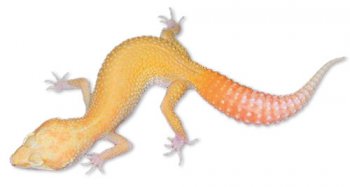 A simple 25-watt light placed on the screen top can provide daylight. Keep it on for 12 hours a day. Because leopard geckos are active at night, they do not need to bask under UVB lighting.
A simple 25-watt light placed on the screen top can provide daylight. Keep it on for 12 hours a day. Because leopard geckos are active at night, they do not need to bask under UVB lighting.
Feed to Breed
Feed breeding leopard geckos crickets at least every other day, or keep a dish of mealworms (Tenebrio molitor) in the enclosure at all times. Insects should be no longer than the leopard gecko’s head and no thicker than half its width. Whether you’re using crickets or mealworms, it is essential that feeder insects be given a balanced diet. Gut load insects with chick or hog mash for 24 to 48 hours before feeding them to your geckos.
It is important that you offer your leopard geckos extra calcium and vitamin D3. Instead of dusting feeder insects, place a jar lid filled with the supplement in the corner of the cage so the leopard geckos can decide how much they consume.
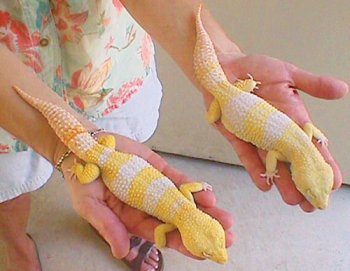 Use a shallow, sturdy water dish measuring 3 to 6 inches in diameter to keep fresh water available at all times.
Use a shallow, sturdy water dish measuring 3 to 6 inches in diameter to keep fresh water available at all times.
Breeding Basics
Typically leopard gecko females are not sexually mature until they weigh 45 grams and reach 9 to 10 months of age.
North of the equator, leopard geckos experience a breeding season running from January to September. Individuals hatched late in the year may not start laying eggs until April of the following season. While we do cool down females prior to breeding, never cool down first-year females because they are still growing. With our other females, we stop feeding 10 days before cooling, then keep them at 74 to 78 degrees Fahrenheit with water present 24/7 for six to eight weeks.
Geckos such as this raptor morph require a hide box measuring 6 to 7 inches in diameter.
When introducing a female leopard gecko to a male leopard gecko, the first thing you may hear is the male going through his tail-vibration routine, which sounds like a very fast rattle. A receptive female stands perfectly still while the male grasps her neck skin in his mouth and engages in copulation. A male restraining a female in this way is normal. A successful mating takes only two to three minutes from start to finish. Remove the female leopard gecko soon afterward.
Egg Laying
Leopard gecko females lay eggs 16 to 22 days after copulation. Once a breeding season begins, you can expect female leopard geckos to lay a clutch every 15 to 22 days over a four- to five-month period. Female leopard geckos may lay one or two eggs for the first clutch of their lives, resulting in eight to 10 eggs for their first breeding year. Leopard geckos can produce 80 to 100 eggs over a lifetime.
RELATED VIDEO



Share this Post
Related posts
Colorful lizard
A very large species of chameleon that is endemic to forests in eastern and northern Madagascar. They reach up to 68 cm (27…
Read MoreDifferent breeds of Lizards
The tables below give you an idea how many species* of reptiles are known. More than a 100 species have been described in…
Read More